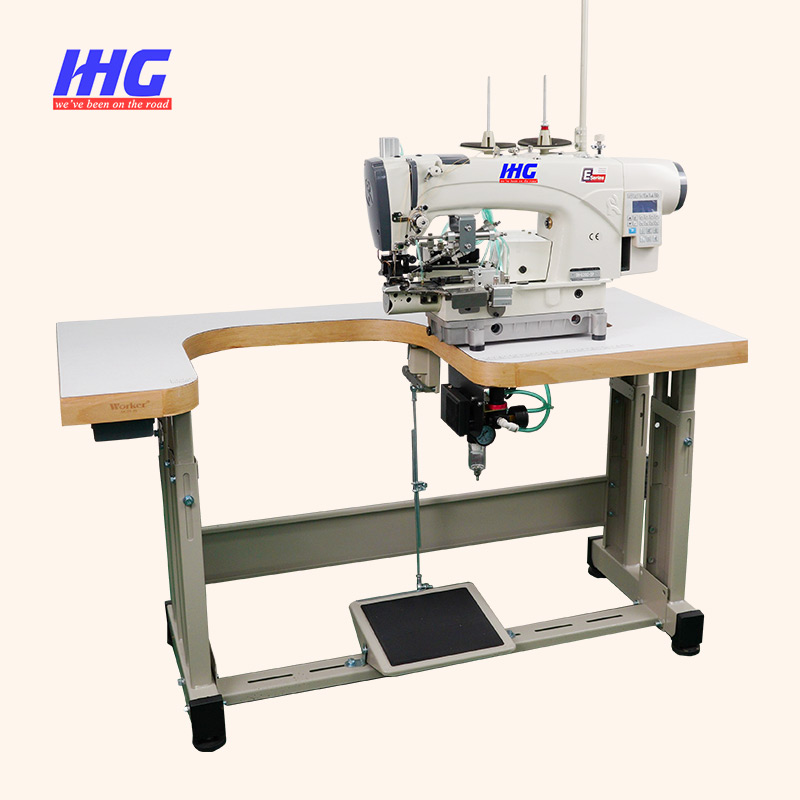
Privacy statement: Your privacy is very important to Us. Our company promises not to disclose your personal information to any external company with out your explicit permission.
![]() May 15, 2021
May 15, 2021
When it comes to sewing, there are two main types of stitches: lock stitch and chain stitch. Each type of stitch has its own advantages and disadvantages. Lock stitches are more durable than chain stitches and are less likely to unravel. Chain stitches are more elastic than lock stitches. We can use it for decorative purposes. The article will explain how they work and how to choose from them to suit your project. We all know the two most common types of stitches used in a sewing machine. The lock stitch is a strong, sturdy stitch that is perfect for seams and hems. The chain stitch is a less sturdy stitch that is best used for stitching around curves. Both kinds of stitches have their pros and cons: - A lock stitch will help prevent fraying but tends to stretch out over time. This means it's not suitable for clothing or home décor items that you want to last forever. If you want to wash your project often, water can get trapped inside the lock stitch seam. It is causing shrinkage and eventual damage to the fabric. - Chain-stitch fabrics are very durable and easy to sew with. It's making them great choices for sewing upholstery, curtains, pillows, rugs, and so on. They're also perfect for quilting as they don't silly at all. Yet, chain stitching is more difficult than lock stitching. It requires some practice before getting comfortable enough to use in everyday sewing. Sewing is a hobby that has been around since before time. Originally we use the sewing machine to make clothing, but today it’s still used for so much more. The most common uses for sewing machines are clothing and home repairs. These days, we use machines for making quilts, apparel, garments, bags, and accessories. And most of the applications are using lock stitch or chain stitch. Here is a video that shows the principle of lock stitch and chain stitch working: The sewing machine inventor was John Jacob Napp. He developed what became known as 'the chain stitch' on an early prototype around 1840. He patented it in England in 1841 and sold the patent rights to Singer Sewing Machine Company in New York City. The Singer company then produced their own version called the "Napp Stitch". They marketed it under the name “The Chainstitch". This invention has been credited with revolutionizing home sewing and the household economy. Because it made clothing production more efficient than ever before. In the 1970s, British researcher Richard Oastler rediscovered Napp’s work. he published his findings in the journal Journal of Textile Research. In 1983, he wrote a book about this discovery. The Invention of Needlework: A Study of William Hocknell's Developmental Work on Needlescopic Mechanisms from 1790-1840. It is now considered one of the most important books on needlework history. Sewing is one of the oldest crafts. It has been passed down from generation to generation. In an earlier era, people used pins to fasten fabric together. But they were cumbersome and not very effective. The hand stitching was more time-consuming, more difficult, much more expensive. Now with all kinds of sewing machines, we are able to make more clothing. We are lessening manufacturing time and material requirements against using traditional methods. Lockstitch stitching is an ancient craft practiced for thousands of years. Many sewing machines have stood the test of time. Each generation has contributed to the growth and change of this industry. Now, modern technology has invented new advancements in commercial sewing machines. Locking stitch is a way of sewing that involves using a locking mechanism. This way, the fabric won't come loose. A lock stitch is simple, fast, and reliable. A lock stitch is basically a loop on the needle. The thread is run through the needle, while the needle remains stationary. It has many advantages as compared to other types of stitches: lock stitch can sew a garment in no time with little or no undoing of the stitching process. lock stitch can sew many pieces at once, thus saving both time and energy. lock stitches are much more secure and less likely to unravel. lock stitches are also more durable, ideal for heavy-duty applications. lock stitches are less likely to pucker or bunch up, a better choice for fabrics that are prone to wrinkling. lock stitch can create decorative pattern designs in your fabric. A lockstitch holds the layers in place but allows the stitches to pass through. Another type of stitch, chain stitch, is known as a "slip stitch". Because it allows the thread to slide through without holding the layers in place. Lock stitch: like chain stitch, it requires the needle to pass through the fabric and then pulls out a loop. When the feeding tooth is feeding forward, it rises again and sets another loop in. But the two thread loops are both connected with another piece of wire loosened from the spool. When the needle sets the thread into the loop, the rotating shuttle grabs the loop with crochet. As the shuttle rotates, it pulls the loop around the wire from the spool. This kind of suture is very strong, not as easy as chain sutures. The difference between lock stitch and chain stitch is a matter of opinion. It's also a matter of how many stitches you want to make. All sewing machines come with two different types of stitches. But it's important to note that these are not the same. On some models, chain stitch is called "lock stitch," but on other models, it's called "chain stitch." This is confusing for consumers! The sewing machines were designed around World War I and World War II. As forms of clothing production for soldiers by civilian manufacturers. who was working at home during wartime shortages? The factories had shut down during wartime. Because they were being used as military facilities. Or because there weren’t enough workers available in their areas. The machine's thread passes through the fabric and is pulled along. It's called a chain stitch. Some machines have a locking stitch. It is a stitch that goes through the fabric layers instead of around them. It's not unusual for a model to have several different types of stitches available on it. Needle technology has improved for sewing machines. Needles are now made out of stronger material and are more durable than ever. It is with a larger eye to pull more fabric through before it is necessary to change out the needle. This allows for faster stitching, as well as a better-finished product. A lockstitch machine has only one set of threads per row: usually white thread on top, black thread on the bottom. Thus saving time while creating a professional finish in your projects. This is easier than using two sets of thread per row on a conventional sewing machine. The seams on the invisible zipper line are always hidden unless the fabric is torn. Another feature of this product is that it can be extended beyond its normal length. This can be used for applique and applique-like stitching. They are used to keep an even look after stitching together many layers of fabric. In addition to the standard lock stitch, you can also use chain stitches on sewing machines. However, they do not require as much thread to pass through the fabric. But it is not as efficient as lockstitch in cutting through the fabric. When you sew, you start with the material under the needle and use the presser foot to hold it in place. When sewing begins, the needle will pass through the fabric, and then the needle will pull out a thread loop. The thread loop will be caught by a device before the needle is pulled out. The sewing machine is moving, and then the needle passes through the fabric again. The thread is again looped around the needle, and then it goes through the fabric a second time. The sewing speed of the chain stitch is very fast, but it is easy to take off the thread. Once a certain position of the stitch is released, the whole sewing line will take off the thread. The difference between chain stitch and lock stitch is a matter of preference. It's not a matter of "which one is better", but a matter of "which one do you prefer". Though both lock stitch and chain stitch are commonly known as ‘sewing stitches’. This is not strictly accurate because they can also be used on knitwear or leather products. Their primary function is decorative rather than functional. But they have different names depending on what they are used for. For example: “lock-stitch” refers to decorative stitches. While “chain-stitch” refers to those used when stitching leather belts or shoes. These types of stitches create curves that look like vines hanging from belt loops. The term "lock stitch" is used when you want less fabric to be pulled through the machine at once. For example, when making a buttonhole or quilting. The term "chain stitch" is used when you want more fabric to be pulled through the machine at once. For example, when making an embroidery or appliqué project. Lock-stitch sewing machines use multiple layers for the same purpose. That is, the needle passes through all layers in succession rather than one at a time. This means that it takes longer for the needle to travel from one layer to another. A chain stitch is an incredibly useful tool in sewing. It will help you create a single line of material. It is a very popular way of sewing clothes and was invented by inventor John Jacob Napp in 1842. But chain stitching didn’t catch on until the late 19th century. There were a few reasons for this. First, it was slow compared to other types of seam making such as lockstitch. But it also had a reputation of being more elegant. In fact, it was seen as more attractive than seams made with separate pins and thread. Today, there are many different kinds of machine stitching. They are used on knitwear, woven fabrics, and leather products. The most popular stitches are zigzag. They are great for creating smooth curves with several layers of fabric. The two basic types of stitches, chain stitch, and lock stitch have many differences. Here are a few things to consider before you decide which one is right for you: * How many stitches/holes do you need? * How much fabric does your project require? * What kind of finish does your project require? * What type of fabric do you have? * How old and worn out is your fabric? * Is your project something that requires flexibility or precision in terms of design? Sewing is a hobby that has been around since before time. Originally the sewing machine was used to make clothing, but today it’s still used for so much more. The most common uses for sewing machines are clothing and home repairs. The same sewing machine can be designed as a lock stitch type or chain stitch type. Such as our Bottom Hemming Machine, we have two solutions of lock stitch and chain stitch. The Lockstitch Sewing Machine is IH-639D-5P/7P. And we also have a chain stitch sewing machine IH-639D-CSHS. Here HS means it’s equipped with a Ho Hsing servo motor. It is with stitch length controlling stepper motor system. In conclusion, the lock stitch and chain stitch are two of the most common types of stitches used in a sewing machine. They each have their own unique benefits, so it is important to choose the right one for the project you are working on. For example, the lock stitch is ideal for projects that require a high level of durabilities, such as upholstery or heavy fabric. Meanwhile, the chain stitch is perfect for delicate fabrics or projects that need to be hemmed. Either of the two can be used separately or together in the same project. It's simply up to you to decide the best one to use on your project.
1. Introduce the difference between lock stitch and chain stitch of the sewing machine.
2. Who invented the first lock stitch sewing machine?
3. What is a lockstitch in a sewing machine?

4. What is a chain stitch in a sewing machine?

5. Lock stitch vs chain stitch: which one is better?
6. How to choose between lock stitch and chain stitch?
7. Conclusion
The above is the Sewing Machine Lock Stitch And Chain Stitch we have listed for you. You can submit the following form to obtain more industry information we provide for you.
You can visit our website or contact us, and we will provide the latest consultation and solutions
Send Inquiry
Most Popular
lastest New
Send Inquiry
Send Inquiry

Mr. Alston Chen
Tel:86-769-18902616250
Fax:86-769-88285668
Mobile Phone:+8618902616250
Email:sales02@chuanghuisew.com
Address:26-28 Zhenglu south, chuancha village, Machong Town, Dongguan City, Guangdong Province., Dongguan, Guangdong
Related Products List
Mobile Site


Privacy statement: Your privacy is very important to Us. Our company promises not to disclose your personal information to any external company with out your explicit permission.

Fill in more information so that we can get in touch with you faster
Privacy statement: Your privacy is very important to Us. Our company promises not to disclose your personal information to any external company with out your explicit permission.